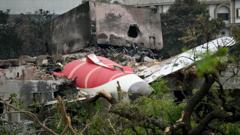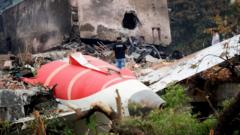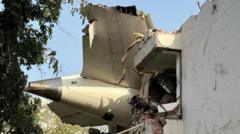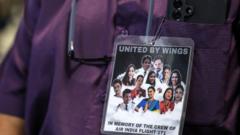The cockpit voice recorder from the Air India flight crash has been recovered, aiding investigators in understanding the incident. Amidst the ongoing inquiry, relatives of victims continue to endure the painful wait for identifications.
Recovery of Black Box Provides Hope in Air India Flight Crash Investigation
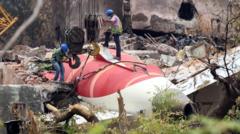
Recovery of Black Box Provides Hope in Air India Flight Crash Investigation
Investigators uncover cockpit voice recorder as they delve into the tragic Air India crash that claimed over 270 lives.
Investigators have successfully retrieved the cockpit voice recorder (CVR) from the wreckage of the Air India flight that tragically crashed shortly after take-off, a significant advancement in determining the cause of the deadly accident that occurred last week. The Boeing 787-8 Dreamliner, en route to London, went down within moments of departing from Ahmedabad, resulting in the loss of at least 270 lives, primarily among passengers.
The CVR records essential audio from the cockpit, including discussions between pilots, alarms, and ambient cockpit sounds. In addition, the flight data recorder (FDR), which captures vital flight statistics such as altitude, speed, and engine performance, was recovered from the debris the day following the crash. Together, these devices, often referred to as the "black box," are crucial for reconstructing the events leading up to the crash and ascertaining its cause. Notably, these devices are brightly colored—typically orange—making them easier to locate amidst the wreckage.
India's Aircraft Accident Investigation Bureau (AAIB) is spearheading the probe into the crash, with support from teams from both the United States and the United Kingdom. This past Sunday, members of the U.S. National Transportation Safety Board (NTSB) examined the crash site. An official statement confirmed that the AAIB is undertaking a comprehensive investigation and that the NTSB is conducting a parallel inquiry in accordance with international protocols, given that the aircraft is manufactured in the U.S. Reports from Indian media suggest that officials from Boeing and the Federal Aviation Administration (FAA) have also engaged with the investigation processes on-site.
In a separate development, an Indian government-appointed committee is set to convene for the first time on Monday to explore the motivations behind the tragic event. This committee is expected to submit a preliminary report within three months, offering new standard operating procedures (SOPs) to prevent similar accidents in the future.
As investigations proceed, families of the victims are faced with the heart-wrenching challenge of identifying remains and coping with their loss following the catastrophic incident. Just seconds post take-off, the AI171 flight tragically collided with a doctor’s housing structure adjacent to the BJ Medical College and Civil Hospital, with only one individual among the 242 onboard surviving. Efforts are underway to ascertain the precise number of fatalities on the ground, as recovery teams gradually match DNA samples for victim identification.
Recent medical reports indicate that 270 bodies have been recovered at the crash site, with over 90 confirmed identities through DNA matching. Among the identified victims is Vijay Rupani, the former chief minister of Gujarat, whose funeral is scheduled for Monday and to be conducted with full state honors.
For countless families still waiting for news of their loved ones, the agonizing process continues. The intricate identification process has been reported as slow, particularly because many remains sustained severe burns due to the fire. Family members, like Mistry Jignesh who is anxiously waiting for updates on his niece’s remains, express their despair over the uncertainty and lengthiness of the identification procedure.
As recovery and investigation efforts are ongoing, the tragedy of the Air India crash continues to profoundly impact families and the larger community.







